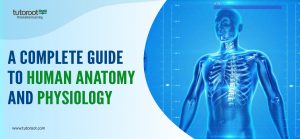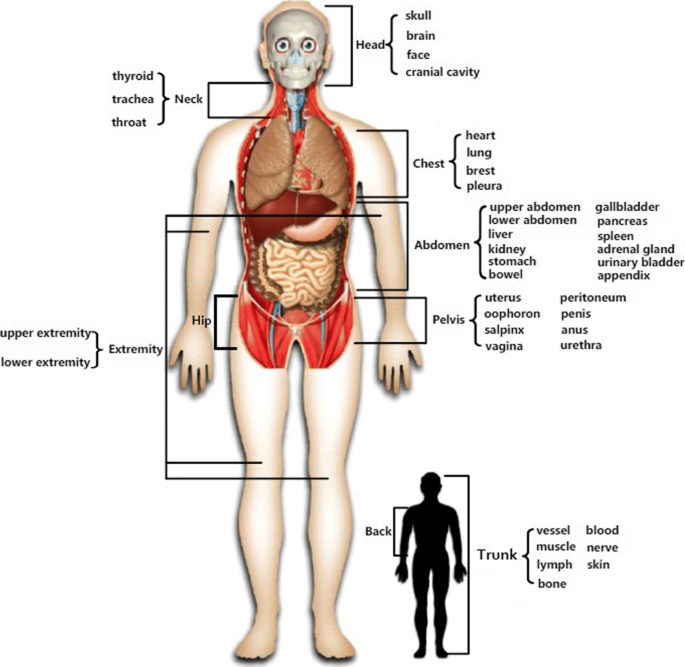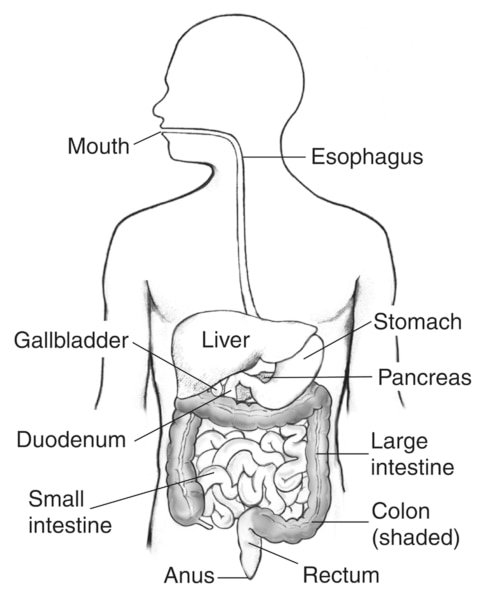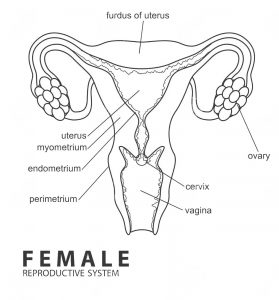A Complete Guide to Human Anatomy and Physiology
Human anatomy and physiology are oriented to assist you in learning and understanding how the human body is organized and works.
The human body is constructed of 30 – 40 trillion cells, with an estimated 242 billion new cells being formed every day. A tissue is formed when a specific set of cells with similar tasks come together. Tissues combine to form organs, and groups of organs combine to form organ systems and finally, a whole organism.
What is Human Anatomy?
Human anatomy is the scientific study of the structures of the human body. Some of these organs are so small that they can only be seen and studied under a microscope. Other structures may be observed, moved, measured, and weighed with ease. Human anatomy was originally studied by analyzing the outside of the body as well as military wounds and other traumas. Eventually, physicians were permitted to dissect the bodies of the dead to advance their knowledge.

Human Anatomy
Skeleton
The human body moves in several ways, including walking, running, crawling, jumping, and climbing. The skeleton is the structure that allows us to carry out all of these tasks. Humans are born with up to 300 bones. With age, however, the bones begin to merge. The total number of bones in maturity is decreased to 206.
The skeleton also shields important organs including the heart, lungs, and liver. Ligaments, fibrous connective tissue, link bones to other bones.
Joints are the locations where two or more bones come together. They allow for a variety of movements such as rotation, abduction, adduction, protraction, retraction, and others. Joints are typed as moveable or immovable based on their flexibility and movement. Movable joints are flexible, while immovable joints are not because the bones are bonded.
Muscles
Muscles are specialized tissues that help the bones move. Tendons connect the muscles to the bones. The contraction and relaxation of the relevant muscles in that area cause limb movement. While joints aid in bone flexibility, a bone cannot be bent or stretched until a muscle works on it. To put it another way, the muscles linked to that bone pull it in the direction of movement.
Additionally, the majority of movement includes muscles that operate in tandem. As we bend our arm, for example, the muscles in that region contract, grow shorter and stiffer and pull the bones in the direction of movement. Muscles in the opposite direction must draw the bones towards it for relaxation (stretching).
Body Parts
Anatomy studies show that human body parts may be classified into nine positions: the head, neck, chest, belly or abdomen, pelvis, back, hip, extremities, and trunk.

Body Structure
The human body is divided into cavities that contain numerous organ systems.
The cranial cavity is the space within the skull that protects the brain and other central nervous system components. The pleural cavity protects the lungs.
The intestines, liver, and spleen are all housed in the abdominal cavity.
What is Human Physiology?
The term physiology is derived from the Greek word meaning natural study. It is the study of how the body and its parts operate or work. It refers to human physical, mechanical, and biological activities. This demonstrates how the human body adapts to physical work, stress, and sickness.
Body Parts and their functions
The body parts include the circulatory system, the Nervous System, the Respiratory System, the Digestive System, the Urinary System, and the Reproductive System (Female and Male).
An estimated 79 organs have been recognized till date. Humans also have organs that have “lost” their function as we have evolved, which are known as Vestigial organs.
There are five critical organs for survival, and any injury to these five organs may result in death. They are the brain, heart, liver, lungs, and kidneys.
The Circulatory System
The circulatory system’s function is to transport blood, nutrients, oxygen, carbon dioxide, and hormones throughout the body. The heart, blood, blood vessels, arteries, and veins form the circulatory system. Circulation consists mostly of two components:
- Systemic circulation
- Pulmonary circulation
Apart from these two types of circulation, there is a third form of circulation known as coronary circulation. Because blood is the body’s connective tissue, it aids in the transfer of critical nutrients and minerals to cells while also transporting waste byproducts away from them.
As a result, it is frequently referred to as the body’s “transport system.” The network of blood arteries, veins, and capillaries in the human body is around 60,00 miles (approximately 96,560 kilometers) long, according to the Cleveland Clinic. The human heart is anatomically comparable to other vertebrate hearts in the animal kingdom, making it a homologous organ.
Digestive System
The digestive system digests food and absorbs nutrients, which the body subsequently uses for development and cell repair.

The digestive system is made up of a collection of interconnected organs they are the mouth, esophagus, stomach, small and large intestines, rectum, and anus.
Mastication (chewing food) is the first step in the process. The saliva then combines with the food to produce a bolus, a tiny circular mass that can be readily swallowed. Then the food chewed moves down the throat and into the stomach. The stomach secretes strong acids and enzymes that break down the meal into a paste.
It then passes into the small intestine, where the meal is further broken down by bile released by the liver and potent pancreatic digestive enzymes. This is where the nutrients from meals are absorbed.
The remaining components (stool) are subsequently transported to the large intestine, where they change from liquid to solid when water is eliminated. It is eventually pushed into the rectum and excreted from the body.
Respiratory System
The process of breathing begins with the inhaling of oxygen and exhalation of the carbon dioxide cycle. Vertebrates, like humans, have lungs that allow them to breathe.
The respiratory system consists of Trachea, Bronchi, Bronchioles, Lungs, and Diaphragm.
Nervous System
The central nervous system maintains and manages intentional and involuntary behaviors. It helps to transmit messages to and from many parts of our body. The nervous system is divided into two categories:
- The Central Nervous System (CNS)
- Peripheral Nervous System
The nervous system regulates both voluntary and involuntary movements and transmits information to various regions of the body. The brain and spinal cord are part of the central nervous system. And the peripheral nervous system is the nerves that connect every other area of the body to the central nervous system.
The Central Nervous System consists of:
Forebrain
Forebrain comprises the cerebrum, hypothalamus, and thalamus. The cerebrum is the biggest portion of the brain. The key activities of this area of the brain include thinking, sensing, directing motor function, receiving and processing information, and comprehending language. Moreover, sexual development and emotional processes are linked to the forebrain.
Midbrain
The midbrain is located between the hypothalamus and the thalamus. The midbrain regulates auditory and visual responses.
Hindbrain
Hindbrain connects the medulla, pons, and cerebellum in the hindbrain. The Hindbrain connects different sections of the brain’s surface to assist in accommodating neurons and connect them to the spinal column.
The peripheral Nervous System consists of:
Somatic Nervous System
The fundamental function of the Somatic Nervous System is to convey motor and sensory signals from the CNS to the brain.
Autonomic Nervous System
This Autonomic Nervous System operates without the user’s involvement. The system facilitates impulse transmission from the central nervous system to smooth muscles and involuntary organs such as heart and lungs.
Reproductive System
The human reproductive system, often known as the genital system, consists of both internal and exterior reproductive organs. It differs between males and females. Connective tissues such as hormones, fluids, and pheromones enable the reproductive organs to function effectively.
Female Reproduction System
The female reproductive system consists of:
Ovaries: These organs are responsible for the production of ovum, or female eggs, as well as the hormone estrogen.
Uterine tubes: Other names for uterine tubes are oviducts and fallopian tubes.

The uterus, often known as the womb, is a pear-shaped organ that houses the developing fetus. The cervix is the entrance site for sperm and the passage to the vagina. During intercourse, the vaginal opening permits the penis to enter and the foetus to depart at delivery.
Male Reproduction System
Testicles, which function as sperm storage, are part of the male reproductive system. The scrotum is a pouch that houses these oval-shaped organs.

The male sexual system’s accessory ducts are placed near the testis. As sperm is formed, it is mixed with fluids from the seminal gland, prostate gland, and Cowper’s gland. The Cowper gland’s primary role is to improve sperm volume and lubricant during intercourse.
Final Notes
Would you want to learn more about such interesting Biology topics? Use Tutoroot’s personalized learning sessions to have access to renowned teachers who will help you understand challenging topics.
FAQ’s
How many systems are there in human anatomy?
The human body has nine primary organ systems. The integumentary system, musculoskeletal system, respiratory system, circulatory system, digestive system, excretory system, nervous system, endocrine system, and reproductive system.
What is the difference between human anatomy and human physiology?
Anatomy studies the internal and exterior structures of the body as well as their physical interactions, whereas physiology studies the functions of those structures.
